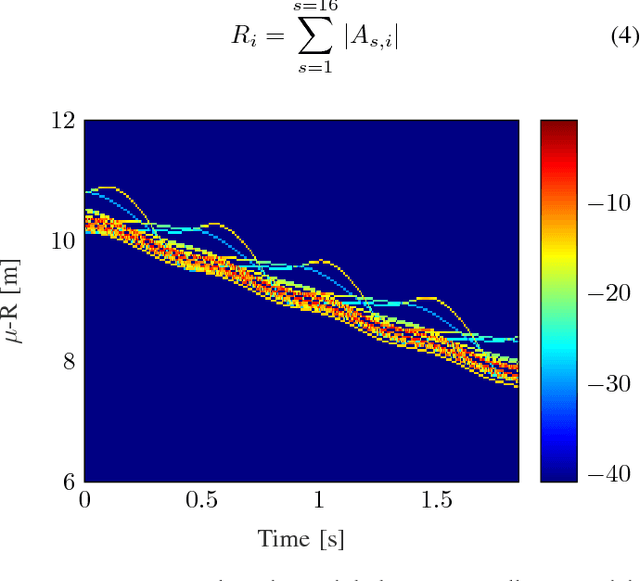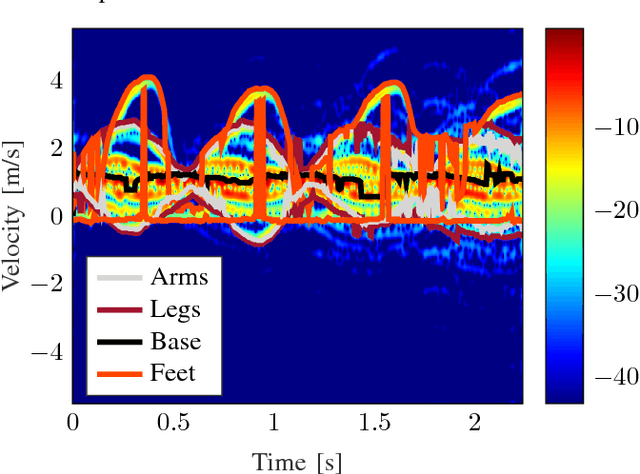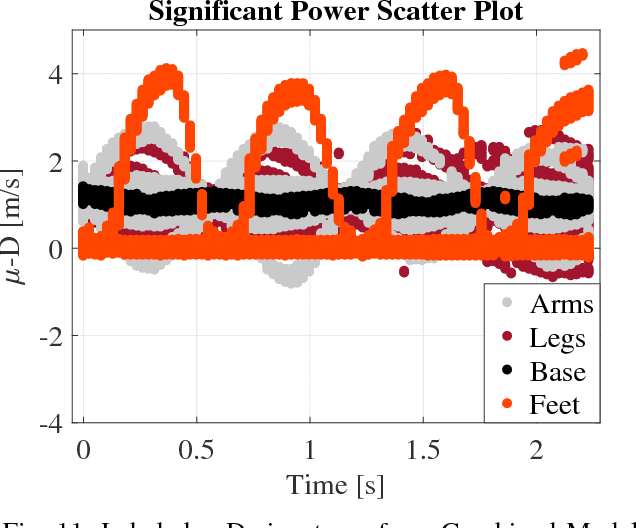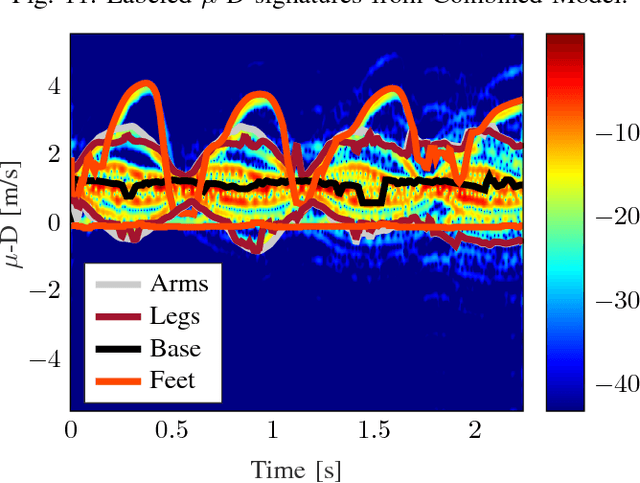Bernhard Kleiner
Fraunhofer Institute for Manufacturing Engineering and Automation IPA
A Study of Human Body Characteristics Effect on Micro-Doppler-Based Person Identification using Deep Learning
Nov 17, 2018



Abstract:Obtaining a smart surveillance requires a sensing system that can capture accurate and detailed information for the human walking style. The radar micro-Doppler ($\boldsymbol{\mu}$-D) analysis is proved to be a reliable metric for studying human locomotions. Thus, $\boldsymbol{\mu}$-D signatures can be used to identify humans based on their walking styles. Additionally, the signatures contain information about the radar cross section (RCS) of the moving subject. This paper investigates the effect of human body characteristics on human identification based on their $\boldsymbol{\mu}$-D signatures. In our proposed experimental setup, a treadmill is used to collect $\boldsymbol{\mu}$-D signatures of 22 subjects with different genders and body characteristics. Convolutional autoencoders (CAE) are then used to extract the latent space representation from the $\boldsymbol{\mu}$-D signatures. It is then interpreted in two dimensions using t-distributed stochastic neighbor embedding (t-SNE). Our study shows that the body mass index (BMI) has a correlation with the $\boldsymbol{\mu}$-D signature of the walking subject. A 50-layer deep residual network is then trained to identify the walking subject based on the $\boldsymbol{\mu}$-D signature. We achieve an accuracy of 98% on the test set with high signal-to-noise-ratio (SNR) and 84% in case of different SNR levels.
Towards Adversarial Denoising of Radar Micro-Doppler Signatures
Nov 12, 2018



Abstract:Generative Adversarial Networks (GANs) are considered the state-of-the-art in the field of image generation. They learn the joint distribution of the training data and attempt to generate new data samples in high dimensional space following the same distribution as the input. Recent improvements in GANs opened the field to many other computer vision applications based on improving and changing the characteristics of the input image to follow some given training requirements. In this paper, we propose a novel technique for the denoising and reconstruction of the micro-Doppler ($\boldsymbol{\mu}$-D) spectra of walking humans based on GANs. Two sets of experiments were collected on 22 subjects walking on a treadmill at an intermediate velocity using a \unit[25]{GHz} CW radar. In one set, a clean $\boldsymbol{\mu}$-D spectrum is collected for each subject by placing the radar at a close distance to the subject. In the other set, variations are introduced in the experiment setup to introduce different noise and clutter effects on the spectrum by changing the distance and placing reflective objects between the radar and the target. Synthetic paired noisy and noise-free spectra were used for training, while validation was carried out on the real noisy measured data. Finally, qualitative and quantitative comparison with other classical radar denoising approaches in the literature demonstrated the proposed GANs framework is better and more robust to different noise levels.
Micro-Doppler Based Human-Robot Classification Using Ensemble and Deep Learning Approaches
Feb 26, 2018



Abstract:Radar sensors can be used for analyzing the induced frequency shifts due to micro-motions in both range and velocity dimensions identified as micro-Doppler ($\boldsymbol{\mu}$-D) and micro-Range ($\boldsymbol{\mu}$-R), respectively. Different moving targets will have unique $\boldsymbol{\mu}$-D and $\boldsymbol{\mu}$-R signatures that can be used for target classification. Such classification can be used in numerous fields, such as gait recognition, safety and surveillance. In this paper, a 25 GHz FMCW Single-Input Single-Output (SISO) radar is used in industrial safety for real-time human-robot identification. Due to the real-time constraint, joint Range-Doppler (R-D) maps are directly analyzed for our classification problem. Furthermore, a comparison between the conventional classical learning approaches with handcrafted extracted features, ensemble classifiers and deep learning approaches is presented. For ensemble classifiers, restructured range and velocity profiles are passed directly to ensemble trees, such as gradient boosting and random forest without feature extraction. Finally, a Deep Convolutional Neural Network (DCNN) is used and raw R-D images are directly fed into the constructed network. DCNN shows a superior performance of 99\% accuracy in identifying humans from robots on a single R-D map.
* 6 pages, accepted in IEEE Radar Conference 2018
Stairs Detection for Enhancing Wheelchair Capabilities Based on Radar Sensors
Nov 25, 2017



Abstract:Powered wheelchair users encounter barriers to their mobility everyday. Entering a building with non barrier-free areas can massively impact the user mobility related activities. There are a few commercial devices and some experimental that can climb stairs using for instance adaptive wheels with joints or caterpillar drive. These systems rely on the use for sensing and control. For safe automated obstacle crossing, a robust and environment invariant detection of the surrounding is necessary. Radar may prove to be a suitable sensor for its capability to handle harsh outdoor environmental conditions. In this paper, we introduce a mirror based two dimensional Frequency-Modulated Continuous-Wave (FMCW) radar scanner for stair detection. A radar image based stair dimensioning approach is presented and tested under laboratory and realistic conditions.
* 5 pages, Accepted and presented in 2017 IEEE 6th Global Conference on Consumer Electronics (GCCE 2017)
Real-Time Capable Micro-Doppler Signature Decomposition of Walking Human Limbs
Nov 25, 2017



Abstract:Unique micro-Doppler signature ($\boldsymbol{\mu}$-D) of a human body motion can be analyzed as the superposition of different body parts $\boldsymbol{\mu}$-D signatures. Extraction of human limbs $\boldsymbol{\mu}$-D signatures in real-time can be used to detect, classify and track human motion especially for safety application. In this paper, two methods are combined to simulate $\boldsymbol{\mu}$-D signatures of a walking human. Furthermore, a novel limbs $\mu$-D signature time independent decomposition feasibility study is presented based on features as $\mu$-D signatures and range profiles also known as micro-Range ($\mu$-R). Walking human body parts can be divided into four classes (base, arms, legs, feet) and a decision tree classifier is used. Validation is done and the classifier is able to decompose $\mu$-D signatures of limbs from a walking human signature on real-time basis.
* 6 pages, IEEE RadarConf 17
 Add to Chrome
Add to Chrome Add to Firefox
Add to Firefox Add to Edge
Add to Edge